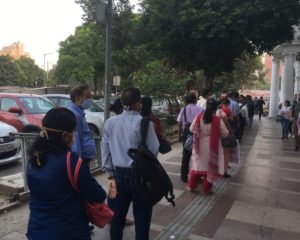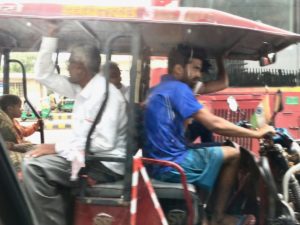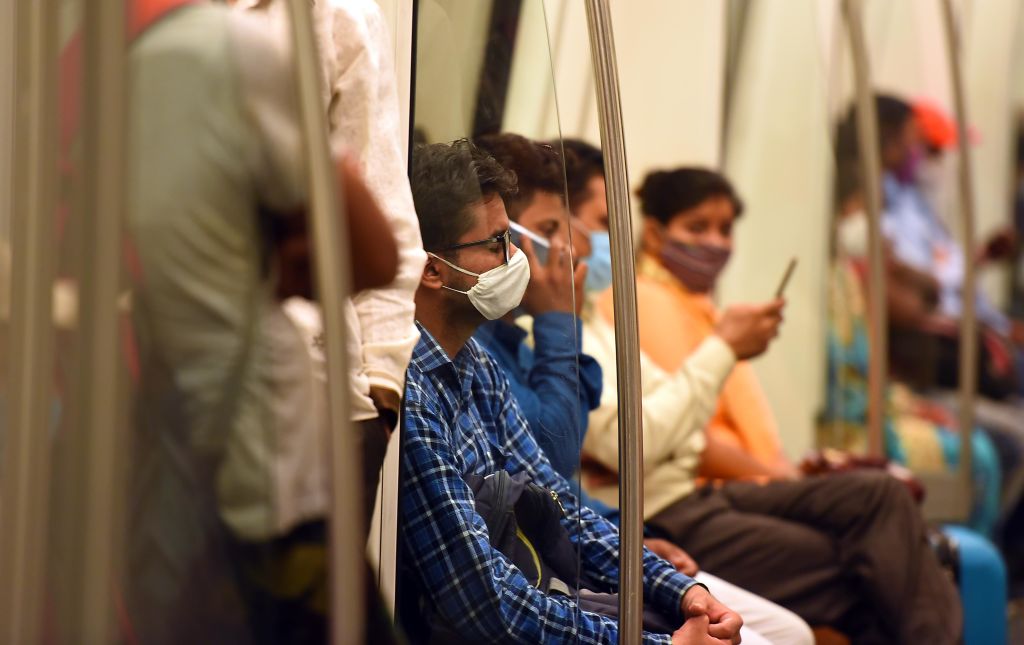As Delhi is limping back to normalcy despite the rising number of Covid cases, more and more people are using public transport. Whether they are safe is anyone’s guess
In a complex metropolis like Delhi, it’s difficult to categorically say if public transport is safe as the number of Covid-19 cases spikes again. But people generally are adamant to get on with their lives and businesses despite the lingering fear of a pandemic.
Delhi is getting back to the normal city life, malls are fairly crowded during the weekends with people hanging out with families—elders and children. The roads are fairly busy during office hours, reminiscent of pre-Corona times. Finally, things seem to be on the move, which is heartening.
On Friday evening, which is the case on most working days, there was a long queue that extended to more than 200 metres at the A-block gate of Rajiv Chowk Metro station. People weren’t too particular about maintaining social distancing but weren’t in violation either. The Delhi Metro is taking all possible precautions that have made getting into the train a little time-consuming, especially during office hours.
“It’s a small price to pay,” says Rukmani, 23, a salesgirl in a multinational apparel store, “they are only trying to keep us safe.” She spends her time waiting in the queue chatting up friends.

Rukmani standing in the queue at Rajiv Chowk metro station (pink bag) //image Mihir Srivastava
Commuters are encouraged to make online payments, though some people experienced glitches, especially at stations like Central Secretariat, Chawri Bazar and Chandni Chowk. The idea is to buy a card so the need to physically purchase a ticket every time one enters the network can be avoided.
In some of the major Metro stations, only a select number of gates are open so as to ensure that all the passengers are properly scrutinised. It takes longer also because there’s an additional layer of security— against the virus—that includes sanitisation and thermal screening of passengers and their luggage.
Personnel of the Central Industrial Security Force (CISF) are at high risk as they provide security cover to the Metro network. Delhi Metro has taken some innovative measures to ensure their safety, like contactless frisking at stations. Rajesh M, (name changed) from Odisha is deployed in Khan Market Metro Station. He explains in Hindi: “Initially, we were paranoid and so were our families. It’s riskier than a combat situation. But, now, after seeing people get on with their lives after some initial glitches, the system seems to be working just fine. Now our anxiety levels are low but I’m constantly thinking about it. There’s fear.”
He informs that some of his colleagues who live with their parents or have younger children sleep in a different room at home, practising social distancing even within family settings. Some even plan to stay away from the family until the numbers of Covid-19 cases come down.
Buses are crowded during office hours — which is the weak link. It’s left to the passenger to make sure that there’s sufficient distance from fellow passengers. One such regular commuter is Ritu Prasad, who works in Nehru Place as a waitress in a coffee shop and travels on route number 514 that connects Sarojini Nagar depot to Kalkaji. Ritu lives with her sister and is always hard-pressed for time as she’s preparing for competitive exams, but has made it a point not to travel in a crowded bus. Thankfully, her timings are such that she can avoid office hours, but one day when she had to leave early, “I let three buses go and waited for more than an hour, as they were all very crowded. “Jaan hai to jahan hai,” she quips.

Bus stand near Nehru Place–Kalkaji //image Mihir Srivastava
Uber and Ola are also functional and more and more people are making use of them. Ranjeet, 23, drives a Maruti Dezire for Uber, he was in his home town of Aligarh for more than five months. He started driving his cab about three weeks back. In Delhi, he stays with his elder sister and brother-in-law and remains confined to a separate room. He avoids interaction with his three-year-old nephew.
He used to drive a truck before he saved enough to buy a cab two years ago, and couldn’t pay his car loan instalment for many months. “This month was the first time I paid after nearly half a year. The bank kept calling me, but they weren’t persistent. Now that I’m working again, I should be able to pay,” he’s confident. But his income has come down drastically, nearly half of what it used to be before the pandemic hit the city. “It’s not easy, sometimes I’m waiting for hours in the car for a passenger,” he explains.
Ranjeet has a transparent plastic sheet that separates the driver’s seat from the rest of the car. “It’s not just about the safety of the customer but my own safety as well. If I’m safe, my customers are safe. But you never know—I drive at least ten strangers a day,” he narrates his predicament but is happy to be working again.
Many of the passengers insist on keeping the window open and keep the air inside the cabin in circulation. He feels that his customers, like him, are getting used to this new normal, living in the age of Corona.
The answer to the question of whether it’s safe to use public transport is: It’s anyone’s guess!





